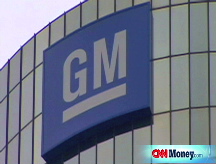GM's toothless restructuring test
Projecting a positive 'net present value' sounds daunting but shouldn't be tough for an often optimistic management team.

NEW YORK (Fortune) -- In lending more than $13 billion to General Motors and Chrysler, the government is making some tough-sounding demands. But at least one of them sounds tougher than it actually is.
Term sheets released Friday call for the companies to present a restructuring plan by Feb. 17 that shows they must be able to reach what's called "positive net present value," or NPV.
That's an assessment of the current worth of expected future cash flows, minus costs such as operating expenses and the repayment of government loans.
Considering GM's dire straits - it lost $38.7 billion in 2007, has burned through billions of dollars in cash this year and had sales plunge 40% from year-ago levels in recent months - positive net present value would seem to be miles away.
But GM (GM, Fortune 500) may be able to post positive NPV with few problems, according to David Merkel, chief economist at Finacorp Securities.
He said net present value calculations depend heavily on the assumptions being made by management. If GM execs make optimistic forecasts about their market share, profit margins and other factors, they should be able to present the Treasury Department with a plan showing they'll hit the positive NPV milestone within a reasonable amount of time.
"This is the weakest possible test," Merkel says. "Unless you specify some assumptions or appoint a neutral third party, you're going to end up with projections that work in favor of management."
As it happens, the term sheet issued by the government Friday doesn't say what assumptions the company should use in assessing its prospects for returning to full financial health. It specifies only that the assumptions be "reasonable" and that GM's calculations take into account "all existing and projected future costs," including repaying taxpayer loans and other financing.
GM's financial projections, to put it mildly, haven't always been reasonable. For instance, GM chief Rick Wagoner projected in 2002 that the company would triple its profits to $10 a share by 2005.
But following the company's failure to deal meaningfully with its bloated cost structure and the bankruptcy filing of parts supplier Delphi, the company actually lost $10.6 billion, or $18.78 a share, in 2005.
Nearly three years later, GM's problems have only gotten worse.
Merkel says a better test of GM's viability would be a clause that let the company keep its loans unless it suffered material financial deterioration. "At least then you'd have a real idea that you could staunch the bleeding," he said. "If you can't do that, what hope do you have?"
Mickey Cargile, managing partner at WNB Private Client Services in Midland, Texas, says that for political reasons, government aid had to be given to GM and Chrysler. So it's not surprising the terms of the loan and the restructuring guidelines aren't watertight.
"They're going to need substantially more money down the road, but for now the goal was to appease Congress and let [the Obama administration] get into office to start dealing with this problem," said Cargile, who doesn't own any GM stock or bonds.
When the new administration does take the reins next month, it will have to confront an issue that GM and its Detroit peers have been struggling with for years: how to restructure the companies to make them viable without shifting the entire burden to employees and retirees whose finances are already under stress.
"The pension and healthcare issues at GM could create a huge human issue," says Cargile. "How you deal with that is still the question." ![]()
-
 The retail giant tops the Fortune 500 for the second year in a row. Who else made the list? More
The retail giant tops the Fortune 500 for the second year in a row. Who else made the list? More -
 This group of companies is all about social networking to connect with their customers. More
This group of companies is all about social networking to connect with their customers. More -
 The fight over the cholesterol medication is keeping a generic version from hitting the market. More
The fight over the cholesterol medication is keeping a generic version from hitting the market. More -
 Bin Laden may be dead, but the terrorist group he led doesn't need his money. More
Bin Laden may be dead, but the terrorist group he led doesn't need his money. More -
 U.S. real estate might be a mess, but in other parts of the world, home prices are jumping. More
U.S. real estate might be a mess, but in other parts of the world, home prices are jumping. More -
 Libya's output is a fraction of global production, but it's crucial to the nation's economy. More
Libya's output is a fraction of global production, but it's crucial to the nation's economy. More -
 Once rates start to rise, things could get ugly fast for our neighbors to the north. More
Once rates start to rise, things could get ugly fast for our neighbors to the north. More









